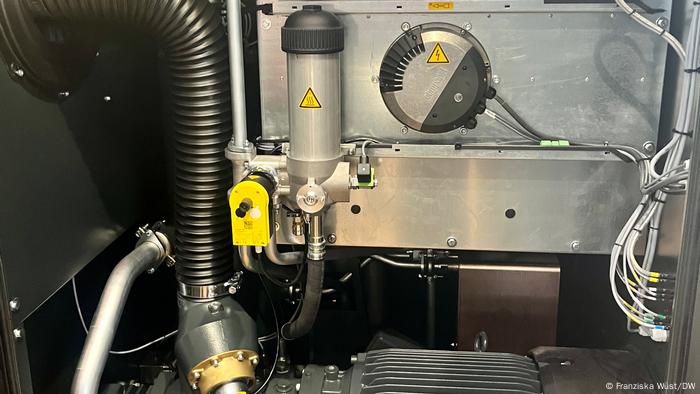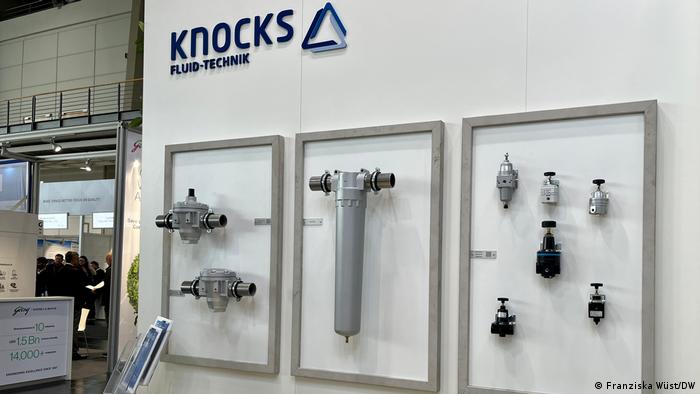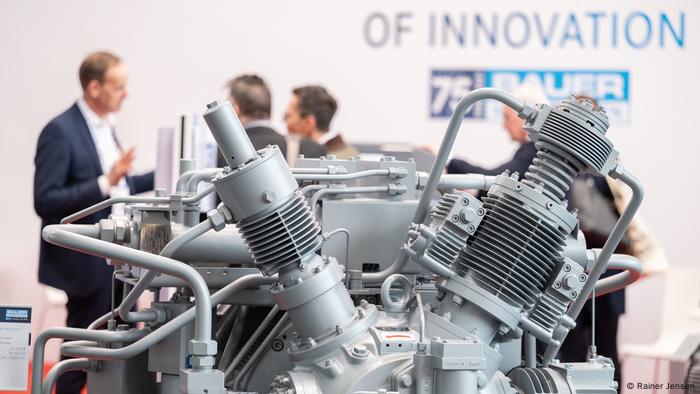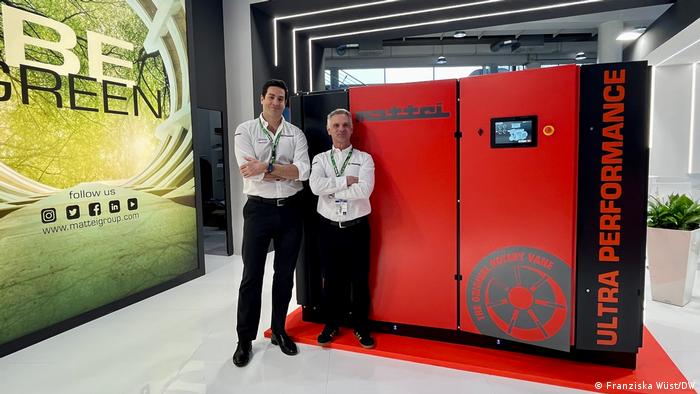The two parallel screws inside the transparent Plexiglas box turn faster and faster the more I move the metal cylinder on the outside. Their helical threads intertwine as they move. “This is really the heart of a compressor. That depends,” says Mario Schnieders from the compressor manufacturer Kaeser, as he puts his hand on the shoebox-sized screw compressor model. With a real compressor, the air would be sucked into the screw press from above and come out on the other side as compressed air. Just compressed.
We are at the booth of Schnieder’s company in Hall 4 of the Hanover Fair, the largest industrial fair in the world.
The countless suits sweeping across the gray carpets between the stands almost disappear here. In the hall for compressed air and vacuum technology, exhibition areas with metal tanks and pipes in countless colors and sizes are lined up next to each other. The wall of a booth is full of small devices. A mixture of air pump and siphon, pipes, metal, tools. A subtle “Pssssss” whistles through the air in some places.
Before my first visit to an industrial fair, I only heard the word “compressor” from my grandfather when he was cleaning the work surfaces in his workshop. Blow over it once, done. But the devices here, this “cross-sectional technology“, as it says on the website of the fair, this year has its own hall on the huge site, where there are a total of 26 exhibition halls. Because without compressed air in industry, as I learned that day, there would be little or nothing.
Energy saving through waste heat
Schnieders leads me to one of the boxy machines that are draped across the booth as if they were rare Art Nouveau furniture from the 20th century. The yellow block, which one would otherwise tend to find in hard-to-reach basement rooms, protrudes just above me.
When Schnieders opens the door to the interior, I feel like looking at the open bonnet of a car: clueless. Black wires lead to what could be a motor, a hidden box above, hoses. Schnieders points to two cables that lead to another box: “Here the warm oil flows into the heat exchanger, where it transfers its heat to the cold water.”
The fact that the thermal energy that a compressor generates as it works is incorporated into other processes is not a new idea, he says. The industry has been working on efficient waste heat utilization for some time.

According to Kaeser, 96 percent of the energy released can be used with the heat exchanger inside the compressor
For example, the device in front of us can be connected to a heating system and thus heat water for everyday use. So far it hasn’t been worth it “because the gas was too cheap,” explains Schnieders with a smile. Sounds like a good deal.
From heart and lungs
“Do you know what kind of air is in a packet of crisps?” Musa Kurtulmus asks me. We take a seat in one of the sofa corners next to the machines. A small wall with flower pots separates us from the bustling corridors. “That’s nitrogen. Otherwise the food wouldn’t last as long.” His company Mikropor “does everything that comes after the compressor”. With their devices, they convert the compressed air produced into nitrogen or oxygen, which in turn is used for breathing masks.
Why should people be interested in compressors, I ask him: “Because of their health, their food. Nothing could be produced without them,” Kurtulmus replies to me. It’s not the first time I’ve heard that sentence today.
The area of application for compressed air and what you can do with it seems limitless. It starts with the robotic mandrels in factories powered by the compressed air; from sorting out rotten raspberries on conveyor belts that get blown away by the pressure, to the sand that has to be blown onto the rails when a train is forced to slam on the brakes.
“This device has been specially adapted for the milking industry,” explains Michael Reinhardt from the Japanese company Anest Iwata. The compressed air would remove the remaining liquid after cleaning the suction cups. The industry would become more and more specific. The more a device is adapted to a specific use, the more money can be saved. “In a company there is a heart and lungs. The heart is the electronics and the compressor is the lungs.”
Massive machines with a retro design
My stroll through Hall 4 takes me past company logos from all over the world – from Turkey, China and Qatar – until I stop in front of a large banner: Compressed Air Since 1919. Directly above: Mattei. If I didn’t know I was at the world‘s largest industrial fair, I would think I was standing in front of an Italian designer shop. The retro font signals more style than industry.
“The compressors are beautiful because we are Italians,” says CEO Giulio Contaldi. His laugh betrays a certain satisfaction. The family business was founded in Milan in 1919 after the First World War, when a lot of industry was needed for reconstruction.
At least 1.90 meters tall, the company boss stands right in front of me and raises his arms, a bit as if he were about to conduct: “If every manufacturer would install highly efficient compressors, the CO2 emissions of the industry could be significantly improved.” Isn’t that a bit high? After all, we’re “only” talking about compressors here, I ask cautiously.
He looks at me with conviction: “With our product we can change the world.”



